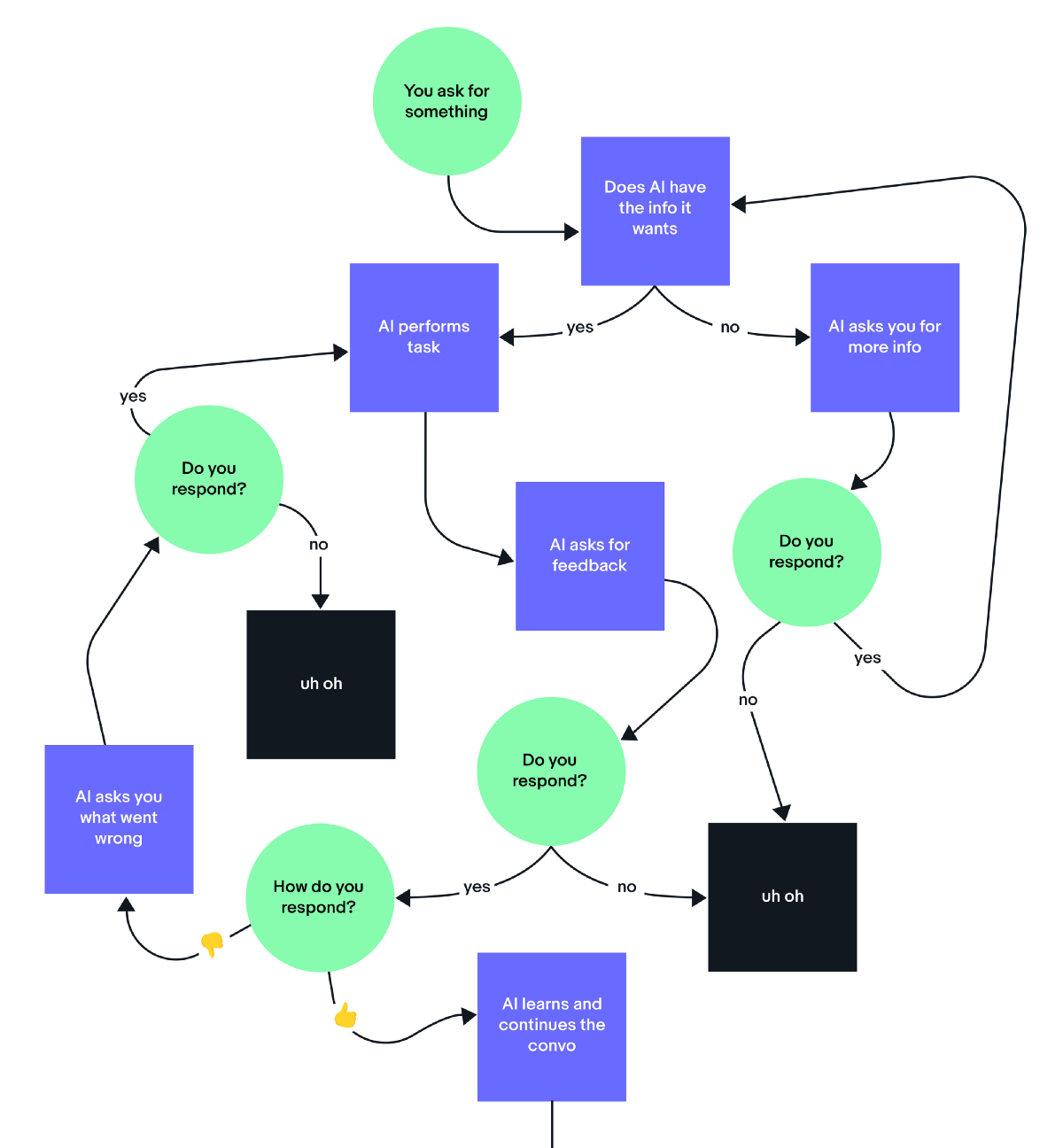Designers today most likely have been designing for products that use some level of AI for automation. We have been designing in the first stage of AI, artificial narrow intelligence. To get to the second stage of AI, artificial general intelligence, we need user data. Lots of it. How do we get this information?
To better understand how design makes AI smarter, first take a quick look at the different stages of AI in You can be an AI designer. Or, come back to it later.
So, data.
Collecting human input and data is crucial to achieving artificial general intelligence. We need to design experiences that incentivize engagement that improves the AI. At times, that means prioritizing AI over users, putting more effort on the users to teach the AI. ????
Designers help artificial intelligence make meaning of user inputs and the implicit signals associated with those inputs. On top of the AI understanding the whats, we decipher the whys from the users’ point of view.
The flow below illustrates a feedback loop between an AI and a human.
Designers need to solve the friction between getting the info the AI needs to know and the info users are willing to provide.
Consider these factors in building a give-and-take relationship between the AI and users.
Be user centric. Create user value.
Focus on the user benefit as a starting point to figure out what the AI needs to learn. Relevant user value can draw people in. Immediate gratification can keep people interested. Apparent improvement or sense of moving forward can engage people in the feedback loop, gaining the data AI needs to get smarter and be relevant.
Prevent dead-ends and keep offering value to users in every step you want them to take.
Focus. Then, expand.
Delivering on the key user value builds trust and engagement between the AI and users. Focus on the key experience and remove unnecessary friction that blocks users from the happy path. Once that user path is solid, which increases engagement, identify what other experiences would enhance the key user value. What knowledge would the AI need to deliver on those experiences?
For example, eBay ShopBot learns about shopping behaviors, inventory, styles, and everything related to shopping. But, it still needs to learn about the world, the weather, current events, trends, and how they all affect decision making. With this extra information, we will be able to design a more thoughtful AI that enhances the users’ shopping experience.
Borrow from humans, but don’t stop there.
Take cues from human interactions, traits, thought processes, and our relationship with computers.
Emotional intelligence: We can teach the AI to be self-aware and socially-aware to bridge the gap and build trust between it and us. Designers are equipped to influence an AI’s emotional intelligence through empathy for the user throughout the product experience.
The AI may not understand the nuances behind what people say and do. But, we do for the most part. The AI needs to recognize the user inputs (words, emojis, gifs, actions, and non-actions) and designers can associate these inputs to possible explicit and implicit user emotions for the AI to learn.
For example, ok and ok… may not always equate to yes. It is our role to identify these nuances so we can teach the AI that ok… may have hesitation, skepticism, or passive aggressiveness attached to it. Paying attention to underlying user intents will help us design more emotionally aware responses from the AI.
Communication style: Currently, humans and computers have a command and respond relationship, with humans commanding. We want to allow the AI to also make these requests and have humans respond. The AI will be more successful in achieving that if it speaks the same language as the user, literally and figuratively.
How the AI represents itself through tone of voice, ways of communication, cultural references, and personality all affect the relationship. Study how the target user communicates with computers, friends, family, and service providers to develop a style for dynamic dialogue. Have the AI communicate in digestible bits, and show empathy and acknowledgement when appropriate. Make difficult questions easy for users to answer to increase the likelihood of getting user data.
Notice that not many AI assistants say sorry. It’s a personality design decision to stay positive and move forward. Provide users with next steps, compensation, suitable alternatives, and immediate gratification as other ways of acknowledging things didn’t go as the user has expected.
Give-and-take relationship: Give users value and take user feedback. The feedback loop is one of the biggest design challenge to improve the AI.
Clifford Nass and BJ Fogg’s study on reciprocity between users and computers found “users may be more likely to agree with, comply with, or help out [a computer] that has previously helped them. This ‘give-and-take’ may also lead to enhanced user performance and increased positive affect.”
Combined with the Hook Model by Nir Eyal, users will be more likely to invest in the AI if they clearly understand and experience the benefits from the investment.
Spotify gives us music we didn’t know we would like. Awesome. It takes explicit signals through thumbs up, thumbs down, and hearts, and implicit signals from passive listening. When we passively listen and not actively give feedback, we end up with songs that we aren’t into. As a result, we learn that we have to be active participants in giving our input so our Discover Weekly playlist will get back on track.
